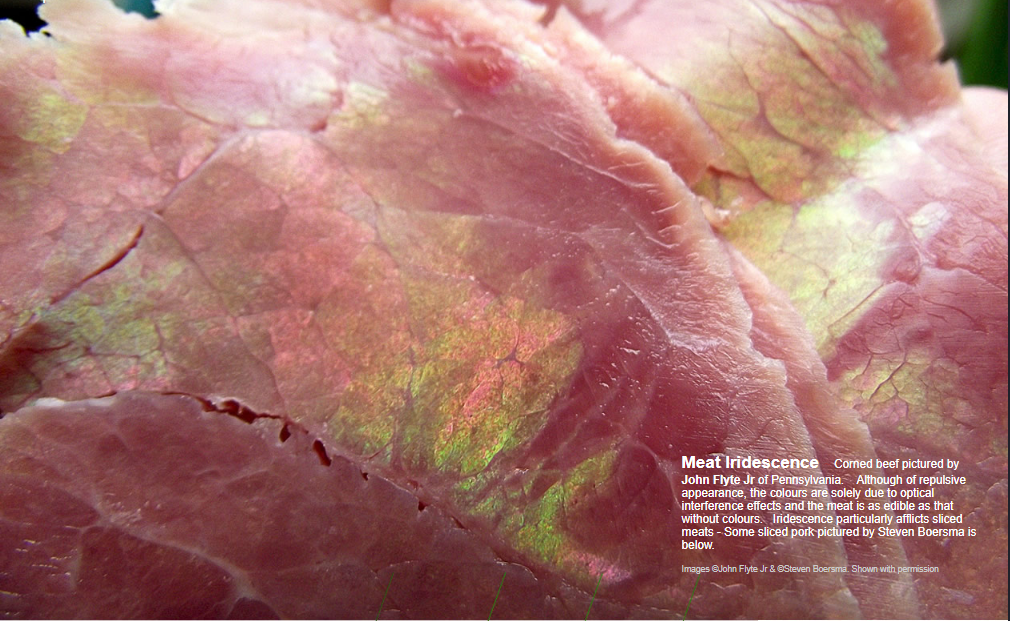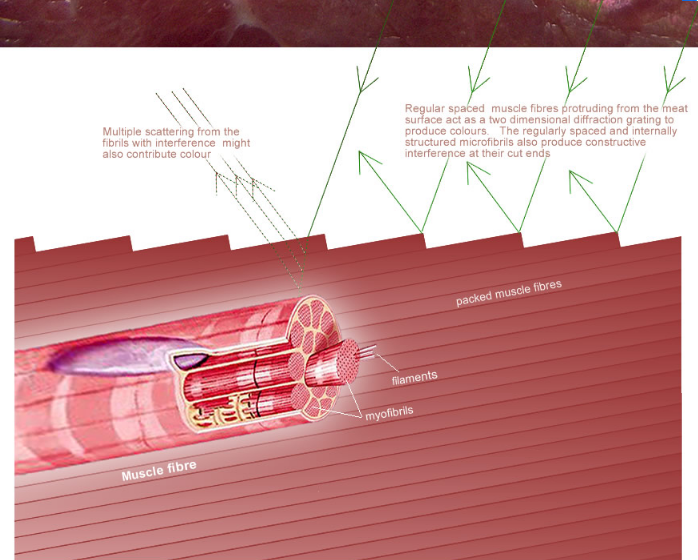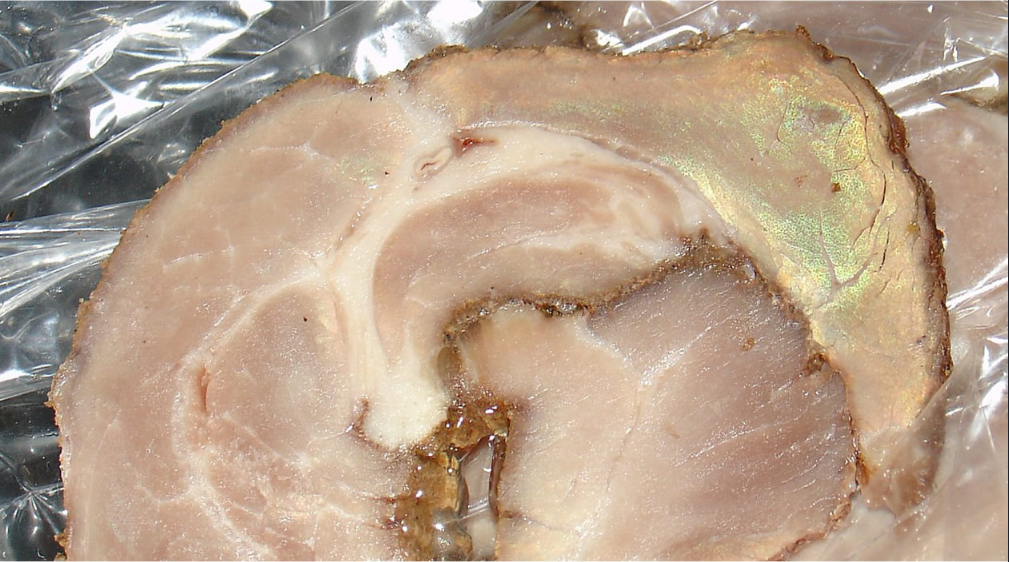OPOD - Meat Iridescence
OPOD - Meat Iridescence: Unveiling the Spectacular Colors of Sliced Meats
Have you ever come across the mesmerizing colors that sometimes appear on sliced meats? It may seem unappetizing at first glance, but fear not! These vibrant hues are purely a result of optical interference effects and do not affect the edibility of the meat. In this article, we will delve into the fascinating world of meat iridescence, exploring its causes, common occurrences, and the scientific principles behind it.
Unraveling the Phenomenon of Meat Iridescence
Meat iridescence is a well-known occurrence that can be observed on both raw and cooked/cured meats. However, it tends to be more prevalent on smooth-surfaced cooked or cured meats. The appearance of these colors can vary depending on factors such as the angle of lighting, the cutting blade used, and the moisture content of the meat. While unpleasant greens are often observed, reds and pinks can also make an appearance.
Understanding the Structure of Animal Muscle
To comprehend the origins of meat iridescence, we must first explore the intricate structure of animal muscle. Animal muscle consists of bundles of individual fibers that are arranged in a quasi-regular pattern. These fibers, in turn, contain long, oriented myofibrils that are also regularly positioned. When meat is sliced, these fibers and myofibrils can partially protrude from the surface, creating a two-dimensional stepped array resembling a diffraction grating. Additionally, microfibrils present at the cut ends of the fibers can act as quasi-periodic scattering areas.
The Role of Optical Interference
When light waves encounter these regularly spaced protrusions and microfibrils on the surface of sliced meat, they undergo constructive interference. This phenomenon leads to the generation of colored light that is emitted in specific directions, resulting in the stunning iridescent display. The colors observed are determined by the wavelength of the light waves involved in the interference process.
The Influence of Birefringence
Another factor that could contribute to meat iridescence is birefringence. Birefringence refers to the property of certain materials to split light into two perpendicular polarization components, each with a different refractive index. In the case of meat, birefringence may arise from the alignment of muscle fibers and myofibrils, causing the light to split and interfere, further enhancing the iridescent effect.
Exploring the Spectrum of Colors
The range of colors exhibited in meat iridescence is truly captivating. Sliced pork, for instance, can display bright greens, golds, and pinks. Although these colors may initially seem unusual on meat, it is important to remember that they are purely optical effects and do not signify any spoilage or harm to the food.
Further Reading and Research
For those eager to delve deeper into the intriguing world of meat iridescence, references (1, 2, 3) provided by Steven Boersma offer valuable insights and additional reading material. By exploring these resources, you can gain a more comprehensive understanding of the scientific principles behind this phenomenon and its occurrence in various types of meat.
In conclusion, meat iridescence unveils a captivating display of colors on sliced meats, offering a unique visual experience. Through the interplay of optical interference effects and the complex structure of animal muscle, these vibrant hues emerge, creating an enchanting spectacle. So, the next time you encounter iridescent colors on your plate, appreciate the beauty of this natural phenomenon and rest assured that it poses no harm to your culinary enjoyment.

Meat Iridescence ~ Corned beef pictured by John Flyte Jr of Pennsylvania. Although of repulsive appearance, the colours are solely due to optical interference effects and the meat is as edible as that without colours. Iridescence particularly afflicts sliced meats - Some sliced pork pictured by Steven Boersma is below.
Images ©John Flyte Jr & ©Steven Boersma. Shown with permission

Meat iridescence colours are a known issue. They occur on raw meat but are perhaps more common on smooth surfaced cooked/cured meats. They depend on the lighting angle. They could depend on the cutting blade and meat moisture content. Unpleasant greens are common, also reds and pinks.
Animal muscle is composed of quasi regularly spaced and oriented bundles of individual fibres. In turn, the fibres contain long oriented myofibrils also regularly positioned. When meat is sliced the fibres and fibrils can partly protrude from the surface to form a two-dimensional stepped array that forms a diffraction grating. Microfibrils at cut fibre ends can also act as quasi-periodic scattering areas.
Light waves scattered by the regularly spaced protrusions and microfibrils constructively interfere and send coloured light in particular directions.
Birefringence could also contribute.
Bright green, gold and pink iridescence in sliced pork. Image by Steven Boersma. Thanks also to Steven Boersma for alerting OPOD to the topic and for further reading references (1,2,3).

Note: this article has been automatically converted from the old site and may not appear as intended. You can find the original article here.
Reference Atmospheric Optics
If you use any of the definitions, information, or data presented on Atmospheric Optics, please copy the link or reference below to properly credit us as the reference source. Thank you!
-
<a href="https://atoptics.co.uk/blog/opod-meat-iridescence/">OPOD - Meat Iridescence</a>
-
"OPOD - Meat Iridescence". Atmospheric Optics. Accessed on April 23, 2024. https://atoptics.co.uk/blog/opod-meat-iridescence/.
-
"OPOD - Meat Iridescence". Atmospheric Optics, https://atoptics.co.uk/blog/opod-meat-iridescence/. Accessed 23 April, 2024
-
OPOD - Meat Iridescence. Atmospheric Optics. Retrieved from https://atoptics.co.uk/blog/opod-meat-iridescence/.